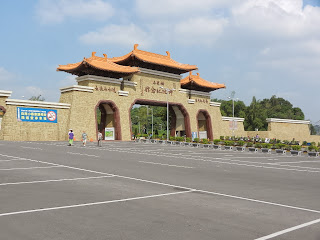TAO TEMPLE
The shipyard is located on Qijin Island, which, as I mentioned earlier, is accessed by a tunnel on the east end and by ferry on the west. We took the Cross Harbor Tunnel each day. As we drove toward the shipyard I noticed several temples in a relatively short stretch of road and inquired as to what they were. Howard explained that they were Tao temples and that there were 60 or 70 on the island.
Considering that the island is about 6 miles long and 1/2 mile wide and that it's north side houses the 4th largest container port in the world, the fact that there were many temples was puzzling. Howard explained that the island was originally inhabited by fisherman and that they tended to be very superstitious.
 |
| Howard and I in front of the Tao Temple |
Taoism is a philosophical and religious tradition that emphasizes living in harmony with the Tao (aka "Dao"). The term Tao means "way", "path" or "principle", and can also be found in Chinese philosophies and religions other than Taoism. In Taoism, however, Tao denotes something that is both the source and the driving force behind everything that exists. It is ultimately ineffable: "The Tao that can be told is not the eternal Tao."
Taoist beliefs
include teachings based on various sources. Therefore, different branches of
Taoism often have differing beliefs, especially concerning deities and the
proper composition of the pantheon (i.e., multiple gods) Nevertheless, there are certain core
beliefs that nearly all the sects share.
Popular Taoism
typically presents the Jade Emperor as the official head deity. Others sects
consider the Three Pure Ones at the top of the pantheon of deities. The
pantheon tends to mirror the bureaucracy of Imperial China; deities also may be
promoted or demoted for their actions.
Taoist
traditions of worship include burnt offerings (Joss paper or “ghost money”), burning
of incense and veneration of the deceased.
 |
| Looking at the gate from the temple |
 |
| Joss paper (Ghost Money) that worshipers burn |
 |
| The Ghost Money is burned in this structure just outside the temple |
 |
| Howard showing me a ball that was carved into the statue not placed in |
FO GUANG SHAN BUDDHIST MEMORIAL CENTER
Our next adventure occurred on Thursday morning (i.e., my final day in Koahsiung) when we visited Fo Guang Shan Buddhist Memorial Center. This was really an amazing sight.
A quick overview of Buddhism, compliments of Wikipedia (edited by me) may help put this into context, especially as it pertains to the amount of money it took to build the center.
Buddhism is a religion indigenous to the Indian subcontinent that encompasses a variety of traditions, beliefs and practices largely based on teachings attributed to Siddhartha Gautama, who is commonly known as the Buddha, meaning "the awakened one". The Buddha lived and taught in the eastern part of the Indian subcontinent sometime between the 6th and 4th centuries BCE. He is recognized by Buddhists as an awakened or enlightened teacher who shared his insights to help sentient beings end their suffering through the elimination of ignorance by way of understanding and the seeing of dependent origination and the elimination of desire, and thus the attainment of the cessation of all suffering, known as the sublime state of nirvāņa.
Two major branches of Buddhism are generally recognized: Theravada
("The School of the Elders") and Mahayana ("The Great
Vehicle"). Mahayana is found throughout East Asia (China, Korea, Japan,
Vietnam, Singapore, Taiwan etc.).
While Buddhism remains most popular within Asia and India, both branches are now found throughout the world. Estimates of Buddhists worldwide vary significantly depending on the way Buddhist adherence is defined. Estimates range from 350 million to 1.6 billion, with 350–550 million the most widely accepted figure. Buddhism is also recognized as one of the fastest growing religions in the world.
The "Center" is set on a 600 acres (100 hectares) site located about 45 minutes north of the downtown Koahsiung. A hectare is 6 acres. It took 7 years to build and was opened 3 years ago.
To give you a sense of its size consider that an acre is 43,560 square feet and that a football field is 45,000 square feet. Therefore 600 acres converts to 453 football fields. This place is enormous.
The photos below will give you a sense of what I saw:
 |
| Main Gate |
 |
| The Reception Center as viewed from the Main Gate (2-3 football fields) |
 |
| The Reception Center is a mall where you can by food, jewelry, clothing, etc. |
 |
| The mall inside the Reception Center |
 |
| The Memorial Center as viewed from the Reception Center The 8 pagodas are called Stupas The distance is perhaps 4-6 football fields |
 |
| View of one of the 8 Stupas |
 |
| Religious art |
 |
| Close up of the Memorial Center The sitting Buddha is behind the building and is surrounded by 4 more Stupas |
 |
| Story of an angry man's encounter with the Buddha (standing figure on right) and how he changed (kneeling figure) Stories where in Chinese and English |
 |
| Another Buddha encounter story |
 |
| Wood carving at the Center Entrance with approximately 500 unique monk head carvings |
 |
| I am standing next to a statue of the monk who was the driving force behind the center |
 |
| Howard Chiu posing in front of the Memorial Center Building Notice two of the 4 Stupas that surround the sitting Buddha |
Written by Les.
Simply desire to say your article is as surprising. The clearness in your post is just cool and i can assume you're an expert on this subject. Fine with your permission let me to grab your feed to keep up to date with forthcoming post. stairwell platform system
ReplyDelete